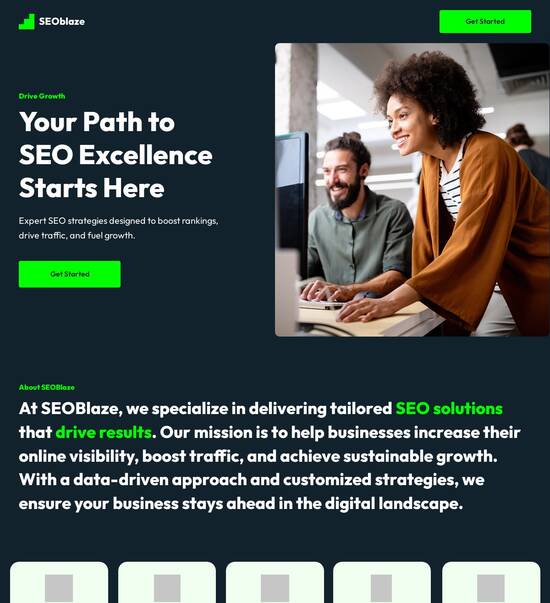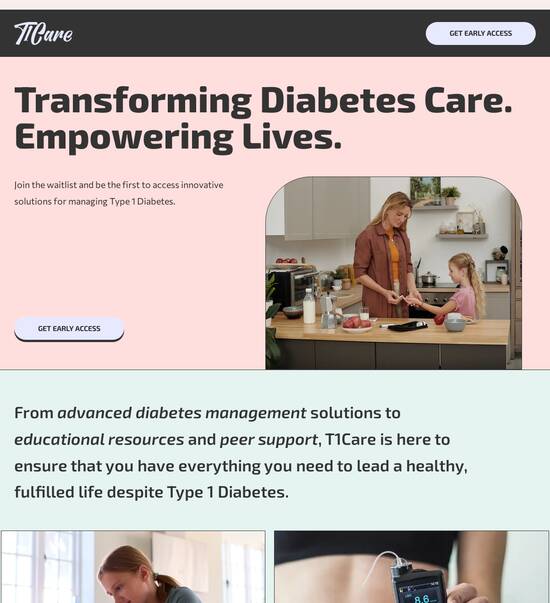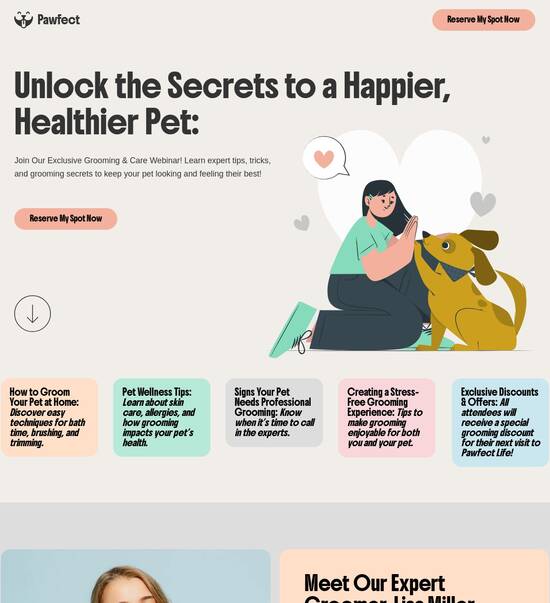
Retro ad campaign page template
Explore Similar TemplatesAbout template
Unleash your creativity with the retro ad campaign page template. Try Instapage today.
Recommended templates

Easy to build without coding
With the intuitive drag-and-drop builder, anyone on your team can create high-converting pages without any knowledge of code or design. Make enhancements to your landing page with custom widgets using Javascript, HTML/CSS, or third-party scripts.

Multiple layouts for any industry and goal
Select from 500+ landing page layouts built to boost conversions across industry-specific scenarios. Customize them by adjusting fonts, adding images, and generating on-brand content with the AI assistant. Quickly scale with Instablocks® and Global Blocks that you can save, reuse, and update globally.

Loads fast and looks polished on any device
Every template is responsive, which means they present professionally on any device and load blazingly fast with our Thor Render Engine. You can also power them up with Google AMP technology to deliver an unparalleled mobile experience and drive higher conversions.

Robust analytics & experimentation
Get real-time updates and reporting across all your devices, showing the number of visitors, conversions, cost-per-visitor, and cost-per-lead. Launch AI-powered experiments, run A/B tests, and use heatmaps to analyze user behavior, then optimize your landing page to maximize conversions.







Easy to build without coding
With the intuitive drag-and-drop builder, anyone on your team can create high-converting pages without any knowledge of code or design. Make enhancements to your landing page with custom widgets using Javascript, HTML/CSS, or third-party scripts.
Multiple layouts for any industry and goal
Select from 500+ landing page layouts built to boost conversions across industry-specific scenarios. Customize them by adjusting fonts, adding images, and generating on-brand content with the AI assistant. Quickly scale with Instablocks® and Global Blocks that you can save, reuse, and update globally.
Loads fast and looks polished on any device
Every template is responsive, which means they present professionally on any device and load blazingly fast with our Thor Render Engine.
Robust analytics & experimentation
Get real-time updates and reporting across all your devices, showing the number of visitors, conversions, cost-per-visitor, and cost-per-lead. Launch AI-powered experiments, run A/B tests, and use heatmaps to analyze user behavior, then optimize your landing page to maximize conversions.
All the features you need to build lead-generating landing pages
Explore more featuresLearn how to build top-performing landing pages for any goal
FAQs
Leading the way in building high-performing landing pages





Maximizing ROI with Instapage: Your ultimate guide to powerful landing pages
Instapage is the powerhouse behind effective landing pages that turbocharge your digital marketing campaigns. Leveraging a user-friendly interface and robust features, Instapage stands out as the go-to platform for marketers across various sectors, including business services, education, and financial services. This guide will walk you through creating high-converting landing pages and answer common queries to help you make the most of Instapage.
Step 1: Choosing the Right Template
Selecting the most suitable landing page template is crucial for your campaign’s success. Instapage offers a vast library of over 100 pre-built templates that cater to multiple industries. Choose a template that aligns with your campaign's goals and audience:
- Focus on conversion: Look for templates specifically designed for lead generation.
- Industry-specific design: Ensure the design resonates with your target vertical's audience.
- Customization options: Opt for templates that allow easy personalization to suit your brand.
Step 2: Optimizing for Conversions
With your template in place, it’s essential to optimize the page for maximum conversions. Utilize Instapage’s built-in A/B testing and analytics features to gauge performance.
- Heatmaps: Use heatmaps to visualize user interactions on the page, allowing you to identify areas for improvement.
- A/B Testing: Experiment with different headlines, images, or calls-to-action to determine what resonates best with your audience.
- Analytics Dashboard: Monitor page performance in real-time to make data-driven decisions.
Step 3: Personalizing Content
Creating personalized experiences is key to engaging your audience. Instapage's dynamic text replacement function allows you to tailor content based on user data and ad targeting.
- Dynamic Text Replacement: Automatically swap keywords in your content based on the user's ad click.
- AdMaps: Align specific ads to unique landing pages to provide continuity in messaging.
- Audience Metrics: Track individual user engagement to refine your personalization strategy.
By following these steps, you can create an optimized landing page that effectively captures leads and maximizes ROI.
Don't miss out on boosting your marketing campaigns with effective landing pages! Sign up for Instapage today and leverage its powerful tools to elevate your digital marketing strategy.
Understanding the retro ad campaign page template
The essence of retro: design aesthetics and nostalgia
Retro design is a dazzling spectrum of colors, fonts, and imagery that carries a sense of nostalgia that many brands love to tap into. This unique aesthetic harks back to earlier decades, such as the 1950s or 1980s, invoking warm feelings of reminiscence. To make the most of a retro ad campaign page template, understanding these core design aesthetics becomes pivotal. By marrying modern marketing strategies with vintage design cues, brands can create an inviting atmosphere that makes their products and services feel both familiar and exciting.
Visual appeal: embracing vivid colors and bold fonts
Key design elements that evoke nostalgia typically include vibrant colors and distinctive fonts reminiscent of bygone eras. Whether it’s the glossy reds and blues from the mid-century or the neon hues of the 80s, color palettes play a crucial role in setting an appropriate vintage tone. Additionally, fonts like serif or hand-drawn styles often transport viewers back in time, ensuring a strong connection with the retro theme.
Color palettes inspired by vintage ads can include combinations like pastel pinks and mint greens or bold oranges and yellows.
Fonts such as Futura, Bebas Neue, and Garamond evoke feelings of nostalgia while maintaining readability.
Textures like grain, paper, or canvas can enhance the vintage feel while ensuring that modern design principles are not compromised.
Iconography and imagery: the power of vintage illustrations
The use of vintage illustrations can significantly influence audience perception and engagement. When brands utilize retro imagery, it often evokes feelings of nostalgia that drive more audacious purchasing behavior. Whether it’s classic products showcased in an old-timey style or playful cartoons that reflect simpler times, the visuals should align well with the brand's message while appealing to emotional sentiments.
Selecting or creating engaging images involves three key considerations. First, ensure that the imagery relates directly to your product or service. Second, pay attention to style consistency—utilize similar color schemes and design elements across all media. Lastly, consider sourcing illustrations or images from reputable platforms that specialize in vintage artwork to maintain authenticity.
Features of the retro ad campaign page template
Features are paramount when it comes to a retro ad campaign page template. An effective template should provide user-friendly customization options to allow marketers to tailor the design and message seamlessly. The drag-and-drop interface makes designing feel intuitive rather than cumbersome, enabling quick adaptations to fit various business goals such as promotions, events, or brand storytelling.
User-friendly customization options
Templates equipped with pre-built sections tailored for specific advertising goals can drastically elevate the speed of campaign production. Marketers can select from various layouts, ensuring that their campaigns remain focused and engaging while reducing the need for code-oriented knowledge to implement changes effectively.
Responsive design: optimizing across devices
With diverse devices in use today, ensuring a retro ad campaign page remains visually appealing across all screens is vital. A responsive design guarantees that campaigns appear polished and professional whether viewed on a desktop, tablet, or smartphone. Testing mobile responsiveness needs to be a priority, as preserving the retro aesthetics while maintaining usability can significantly impact audience engagement and conversion rates.
SEO-optimized structure for enhanced discoverability
Equally important is an SEO-optimized template structure that bolsters search engine ranking. Essential components include optimized header tags, meta descriptions, and image alt texts that resonate with retro-themed keywords. Using best practices for content optimization can make or break a campaign by determining how easily potential customers can find it online.
The importance of rights management in retro campaigns
While the creative aspects of retro campaigns are thrilling, understanding rights management is crucial to avoid legal issues. Utilizing vintage materials often raises questions of copyright, especially if illustrations, fonts, or any other elements are sourced from historical works. As tempting as it can be to grab any vintage image that appeals to you, it’s vital to know the legal landscape and ensure you have the proper rights or licenses.
Copyrights and usage rights for vintage materials
One approach to mitigate legal risks involves using public domain images or licensed content through reputable resources. It’s also advisable to reach out directly to artists or platforms for rights to reproduce any content that falls outside these parameters. By doing so, brands can keep their campaigns authentic while respecting the original creators.
Identity provider integration for user verification
In addition to rights management, incorporating identity providers can bolster campaign security, especially when gathering user data. Utilizing identity verification can protect sensitive information from breaches, ensuring compliance with privacy regulations. This security feature must seamlessly blend with the nostalgic branding to maintain the campaign's integrity and appeal.
Collaborative opportunities: optimizing with your team
Collaborative features in retro ad campaign page templates further enhance the creative process. Having tools for team coordination ensures that every stakeholder is aligned with the project’s vision. As campaign strategies evolve, the importance of communication cannot be understated—notably in maintaining the integrity of the retro theme while adapting ideas and suggestions.
Team coordination and communication tools
Effective project management architecture allows team members to provide real-time feedback. This interaction can enhance the output quality significantly, ensuring everyone contributes to the aesthetic and strategic goals. By focusing on collaborative efforts at every stage, brands can maintain a cohesive narrative that resonates with their audience.
Logs and version control: documenting the creative process
Maintaining thorough logs of changes and utilizing version control is equally important. The ability to track alterations and iterations can enhance collaborative efforts and ensure accountability within the team. This meticulous documentation serves not only as a record of development but can also present opportunities for reflective practices, allowing the team to evaluate what worked well and what didn't in their retro design approach.
Engaging content strategies tailored for retro themes
Crafting engaging content strategies that align with retro themes requires an understanding of emotional triggers. To successfully attract your audience, the copy must evoke memories connected to the era being highlighted. This connection can be established through vivid storytelling that resonates with the audience’s emotions, helping bridge the gap between nostalgia and modern marketing objectives.
Crafting compelling copy that speaks to nostalgia
Techniques for writing nostalgic copy often include referring to cultural markers from the past—such as music, movies, or fashion—to create a familiar backdrop for the audience. By using imagery-rich language and relatable scenarios, brands can engage customers on a deeper level and encourage emotional connections that lead to conversions.
Utilizing multimedia: videos and audio clips for added impact
Incorporating multimedia elements like retro-themed videos and sound clips can heighten engagement further. These elements can captivate the attention of viewers and offer multi-sensory experiences that linger in their memory. Carefully selected background music and sound effects in line with the chosen retro theme can enhance the overall advertising experience, making it unforgettable.
Measuring success: analytics and performance metrics
Measuring the success of any ad campaign, including those with retro styles, hinges on well-defined performance metrics. Setting KPIs tailored to retro campaigns is crucial to gauge effectiveness. These metrics might track user engagement rates, conversion rates, and overall campaign reach, ensuring that every effort toward a nostalgic appeal is grounded in quantifiable success.
Setting KPIs for retro campaigns
Key performance indicators could be derived from engagement with various components of the ad, such as clicks on specific media or interactions with content. Analyzing engagement data can offer insights into which elements successfully resonate with the audience, leading to refined approaches for future campaigns.
A/B testing: fine-tuning your retro ad page
A/B testing plays a vital role in optimizing retro ad pages. Brands can experiment with different design variations to identify which elements create the strongest connection with users. Steps to effectively implement A/B testing include defining goals for each test, creating variations of the elements in question, and meticulously analyzing the results to inform future design and content strategies.
Looking ahead: the future of retro in digital marketing
The future of retro in digital marketing inevitably lies in its remarkable ability to evoke emotion and steer consumer behavior. Emerging trends indicate that nostalgia-driven designs will continue to flourish, suggesting a potential shift towards more personalized experiences in marketing. As brands aim to connect with customers on a deeper level, incorporating retro elements could become a substantial piece of the marketing puzzle.
Trends to watch in 2024: why retro is back
As 2024 approaches, we are witnessing a resurgence of retro designs in contemporary marketing. Analysts predict that this trend stems from individuals’ inherent desire for familiarity and comfort in uncertain times. In light of this, businesses that tap into nostalgia will likely see increased engagement as they cater to this growing consumer preference.
Adapting the template for future campaigns
To keep the retro template relevant, brands must be adaptable and ready to integrate emerging technologies alongside nostalgic design cues. Staying in tune with fashion, cultural changes, and consumer preferences can help refine campaigns to maintain their appeal. Evolution is key; by embracing contemporary elements without sacrificing vintage charm, the retro campaign page template can remain a versatile asset.
Case studies: brands successfully utilizing retro campaigns
In exploring successful retro campaigns across various industries, brands have proven the effectiveness of nostalgia in their marketing strategies. For example, companies like Coca-Cola and Volkswagen have artfully leveraged their historical significance, evoking feelings of nostalgia while maintaining relevance within modern consumer culture. This blend of past and present provides a roadmap for new brands seeking to forge emotional connections.
Analyzing successful retro campaigns from various industries
Coca-Cola's holiday campaigns consistently represent an iconic example of utilizing retro elements, often featuring vintage-inspired visuals and messaging. Similarly, Volkswagen's 'Think Small' campaign successfully tapped into the minimalist aesthetics of the 1960s, crafting a narrative that resonated powerfully with consumers. Each case study presents invaluable insights into the strategies employed to elicit nostalgia while achieving present-day sales objectives.
Insights and key takeaways from real-world applications
Understanding the lessons from these successful retro marketing initiatives highlights the importance of authenticity. Brands should ensure that retro strategies align seamlessly with their core values and messaging. A genuine approach can help maintain brand trust and loyalty while optimizing for new, nostalgic connections that can ultimately drive conversion rates.
Ready to skyrocket conversions?
Supercharge your ad campaigns with high-performing landing pages
Get started














